―
Global Gender Gap Report 2022
―
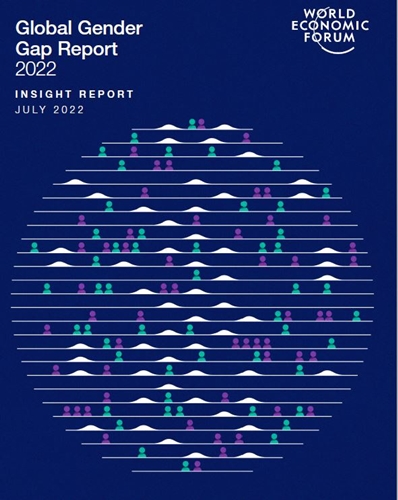
https://www.weforum.org/reports/global-gender-gap-report-2022/digest
Will we live to see gender equality be achieved during our lifetime?
Studies show that it will take another 132 years to close the global gender gap.
World Gender Gap Report was published by the World Economic Forum (WEF) on July 13th, which analyzed the gender gap in 146 countries. The gender gap index was first introduced in 2006 and benchmarks the progress toward gender parity in four areas: economic participation and opportunity, education attainment, health and survival, and political empowerment.
The closer the gender gap index is to 1, the smaller the gender gap and the closer it is to achieving gender equality.
The gender gap is evaluated without considering the economic and social levels of each country. Therefore, even if the overall status and level of women in a particular country is high, if it is lower in comparison to that of men, the gender gap index will be low.
―
Global gender gap score in 2022 is 68.1%
―
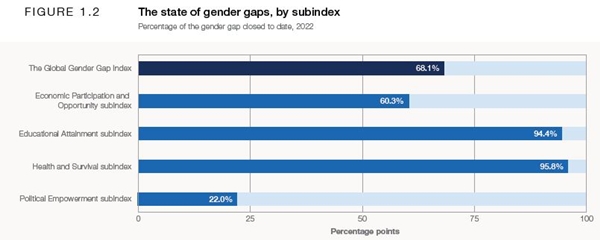
Assuming that men and women have achieved gender equality at 100%, the global gender gap score as of 2022 was 68.1%, with slight increase from 67.9% in 2021.
By subindex, the economic subindex increased from 58.7% to 60.3%, and the health subindex increased from 95.7% to 95.8%. On the other hand, the education subindex decreased from 95.2% to 94.4%, and the political subindex remained the same at 22%.

The report reasoned that the 1.6% increase in the economic subindex was mainly due to the decrease in the wage gap, even though the gender gap in the interests and labor force of women in professional and technical positions have increased.
The increase in the health subindex was only 0.1%. Overall, the level of the gender gap has shown little progress, shortening the time by only 4 years in comparison to the 136 years in 2021.
In 2019, the global gender gap was less than 100 years, but the gap has widened since the pandemic.
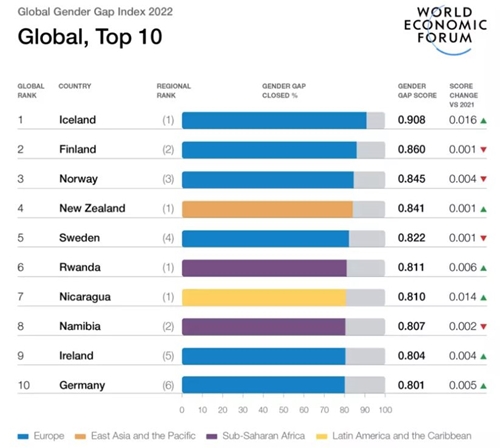
Iceland has the smallest gender gap, with a gender gap index of 90.8%.
Finland has the second highest gender gap index (86%) and Norway is 3rd (84.5%), followed by New Zealand (4th), Sweden (5th), Rwanda (6th), Nicaragua (7th), Namibia (8th), Ireland (9th), and Germany(10th) on the top ten list.
―
Regional Gender Gap
―
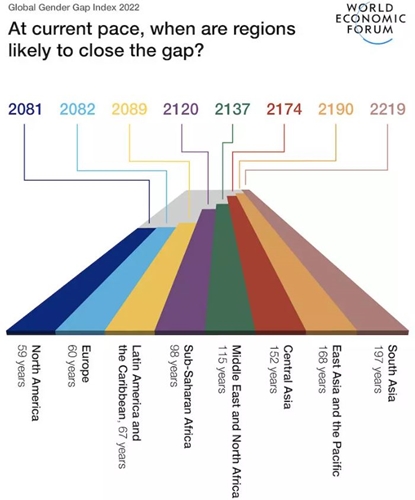
Here is a summary of gender disparity by region:
◎ North America: 76.9% ― The closest to gender equality.
◎ Europe: 76.6% ― Six of the top 10 countries are in Europe.
◎ Latin America and the Caribbean: 72.6% ― Ranking is 3rd as a region. However, only 6 out of 22 countries have improved gender gap scores by more than 1%, and there is a high gap among regions.
◎ Central Asia: 69.1% ― Score remains the same from 2021 with delays in improvement.
◎ East Asia and the Pacific: 69% ― 13 out of 19 countries have made progress since 2021. But it would take 168 years to achieve full equality.
◎ Sub-Saharan Africa: 68.7% ― Nigeria, Ethiopia, the Democratic Republic of the Congo, and Kenya showed positive changes in the economic gender gap, leading to an increase of 1.1%.
◎ Middle East and North Africa: 63.4% ― The second largest gender gap in the world. However, many nations have improved women's participation in the workforce especially roles in technology.
◎ South Asia: 62.3% ― The largest gender gap in the world. Scores are low in all areas and little progress has been made in most nations since 2021. It would take 197 years to achieve full equality at current rates.
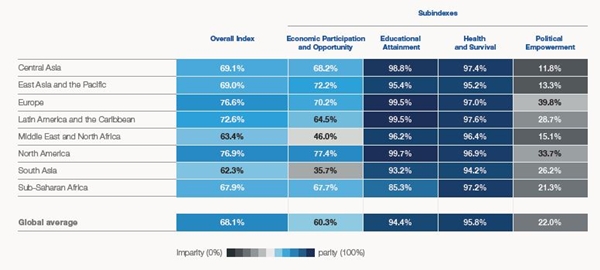
(Gender Gap Subindex by Region and Sector)
―
Gender gap in the workplace widened by the Pandemic
―
The World Economic Forum expressed concern over the widening gender gap in labor force participation as a looming crisis.
The gender gap in the labor force has been declining slowly since 2009 but saw a sharp increase since the 2020 Pandemic. The score has reached 62.9% in 2020, the lowest since the index was first compiled.
Why did the pandemic widen the gender gap? This is because the service industry, where many women have entered, has been hit directly by the lockdown.
In addition, due to the blockade of medical and educational facilities, women are now taking full responsibility for family care and child rearing, serving as a major cause of the widening gender gap.
Even before the pandemic, men accounted for 19% of the time in this field, while women accounted for 55% of the time.

The World Economic Forum, citing LinkedIn data, found that in most countries and industries around the world, only about 30% of women occupy leadership positions.
This is data released in May by LinkedIn, a leading US recruitment company, which analyzed the information of more than 83,000 members around the world and announced the gender gap in jobs.
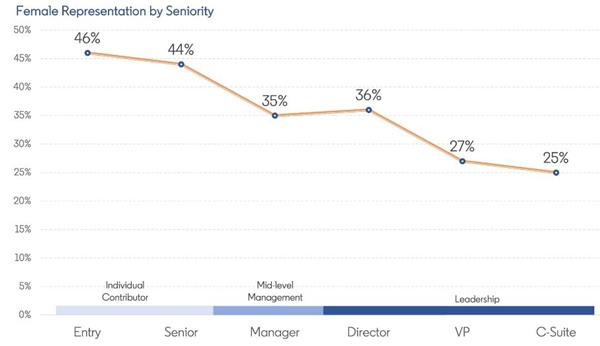
(Percentage of women by position: higher positions to the right)
https://linkedin.github.io/gender-equity-2022/
(Link to LinkedIn Resources)
The gender gap by industry sector according to LinkedIn data is as follows:
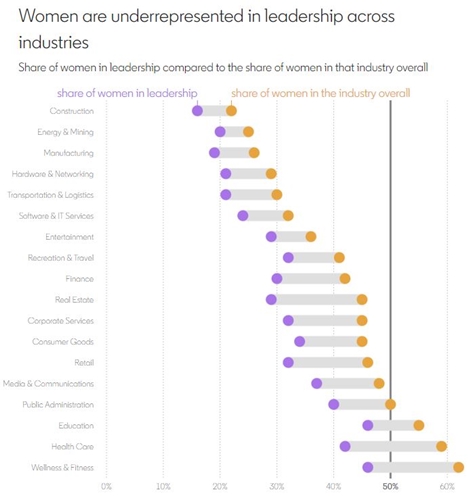
Areas with the highest proportion of women in leadership were △Non-Governmental and Member Organizations (54%), △Education (49%), △Government and Public Sector (46%), △Personal Services and Welfare (46%), △Medical and Medical Services (46%), △Media and Communications (46%).
In contrast, sectors with a high proportion of male leadership were △Technology (30%), △Agriculture (28%), △Energy (25%), △Supply chain and transportation (25%), △Manufacturing (22%), △Infrastructure (21%).
Additionally, in higher education worldwide, women are more likely than men to focus on education and health and welfare fields and tend to be weaker in the STEM fields. There are nearly four times as many male graduates as female graduates in information and communication technology (ICT) and engineering and manufacturing fields.
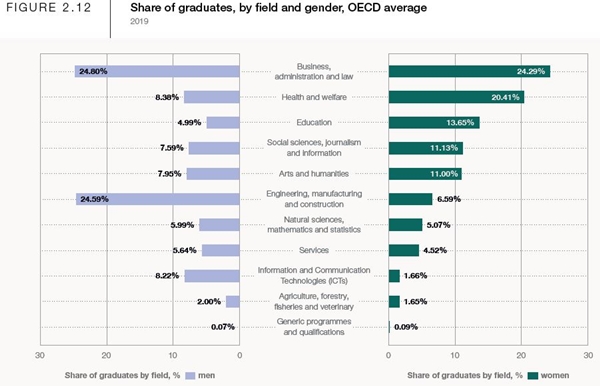
(Gender ratio by occupational group in OECD countries)
Women's entrepreneurship was on the rise, especially in 2020, when the pandemic hit. LinkedIn said it's still unclear whether this trend is good or bad for women.
However, it is questionable why women started a business that can be difficult enough in normal times during a period of uncertainty and instability called a pandemic. In many cases, it is highly likely that women were driven to start a business due to an unequal situation.
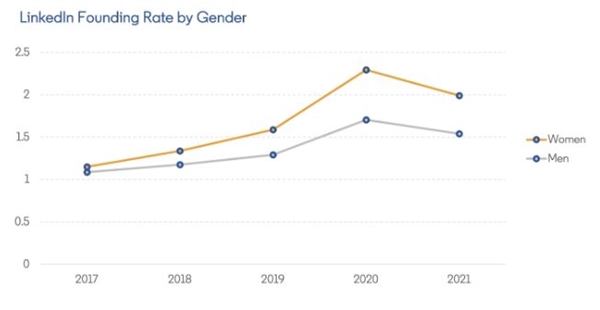
(Founding Rate by Gender)
Saadia Zahidi, Director of the World Economic Forum, stated, “During the coronavirus pandemic, the cost-of-living crisis caused by the labor market shock and lack of care infrastructure is unduly affecting women. We need to make efforts to support policies to support the return of workers to the workforce and to develop female talent in future industries.”
Going back to the report, Rwanda (6th) and Namibia (8th) in Africa, and Nicaragua (7th) in Central America stand out among the top 10 countries. So, where did the powerful nations we call developed countries rank? The US ranked 27th, the UK 22nd, South Korea 99th, China 102nd, and Japan 116th. It is apparent that efforts for gender equality have little to do with a country's economic power.
It will be interesting to see what changes take place in the rankings next year.
Written by Sharon Choi
Director of Planning
Sunhak Peace Prize Secretariat

